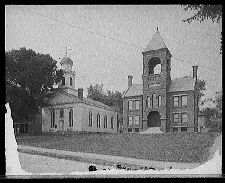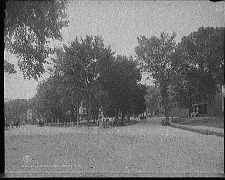The Old Spirit—
Is It Civic Community?
Comment
Symbols of lost civic spirit abound in New England.
The Congregational Church and new Courthouse, 1908

In historic Plymouth, New Hampshire, my home village, religious and civic communities overlapped, as typical of New England in the seventeenth and eighteenth centuries. By 1836, the buildings of the three main civic institutions—Grafton County Courthouse, Congregational Church, and Holmes Plymouth Academy—symbolized this congruence by lining up together along side the village “common.”
Though a unified community was not a fiction, it was never uncontested. Its unraveling proceeded in step with its construction. In 1764, the land grant's Proprietors voted to pay the first permanent Congregational Minister, Nathan Ward, out of property taxes. In 1780, the village Selectmen (the township having incorporated in 1766) agreed that “dissenters”—primarily Baptists—need not pay taxes for a minister not of their faith.
The State made the division of town and church official in the Toleration Act of 1819. The Congregational meeting house nonetheless served as the town meeting hall, indicative of lingering consensus for a unified religious and civic community, until 1836, when the town finally rented a separate public meeting hall.
The Plymouth Common, 1908.

The “common” itself was an ambiguous symbol.
Several private citizens and the county divided ownership of the land, which remained an undeveloped lot between intersecting roads for most of the nineteenth century. The Russell family, who owned a dry goods store adjacent to the undeveloped intersection, were a leading force for a centralized village over three generations. They were largely responsible for situating civic buildings along the “common” (and near their store).
In 1892, the town purchased the land and dedicated it as a public park, naming it “Russell Square.”
Within a generation, the origins of the park were forgotten. Even my grandmother, Susan Colby Tobey, who lived in an apartment overlooking it in 1903 to 1905, and grandfather Fred Tobey, whose Tobey Lumber Company offices also overlooked the park for three decades, referred to it as the “common.” It had never been.
Photographs of Plymouth common and civic buildings are from the Library of Congress Detroit Publishing Co. online exhibition.